Zoonoses in ophthalmology. Part I ? Toxoplasmic recurrent retinochoroiditis
Main Article Content
Abstract
Toxoplasma gondii invasion is probably the most common parasitosis in the world. It estimated that up to half of the world population can be infected with it. This parasite is an opportunist and rarely causes disease symptoms that are unspecific, mild and quickly disappearing, so the existence of this disease is widely ignored. However, in Poland toxoplasmosis is the most common cause of posterior segment inflammation and estimated to affect about 300,000 people. Although ophthalmologists often see old, inactive toxoplasmosis scars, an active toxoplasmic lesion can cause some difficulties in diagnosis and treatment. This article is based on the latest and relevant literature to help ophthalmologists understand, diagnose and treat this disease.
Downloads
Article Details

This work is licensed under a Creative Commons Attribution-NonCommercial-NoDerivatives 4.0 International License.
Copyright: ? Medical Education sp. z o.o. License allowing third parties to copy and redistribute the material in any medium or format and to remix, transform, and build upon the material, provided the original work is properly cited and states its license.
Address reprint requests to: Medical Education, Marcin Kuźma (marcin.kuzma@mededu.pl)
References
2. Sroka J, Wójcik-Fatla A, Dutkiewicz J. Occurrence of Toxoplasma gondii in water from wells located on farms. AAEM 2006; 13: 169-75.
3. European Food Safety Authority. The European Union Summary Report on Trends and Sources of Zoonoses, Zoonotic Agents and Foodborne Outbreaks in 2012. EFSA Journal. 2014; 12(2); 3547: 209-17.
4. Brydak-Godowska J, Moskal K, Borkowski PK et al. A Retrospective Observational Study of Uveitis in a Single Center in Poland with a Reviev of Findings in Europe. Med Sci Monit. 2018; 24: 8734-49.
5. Holland GN. Ocular toxoplasmosis: a global reassessment. Part I. Epidemilogy and course of disease. Am J Ophthalmol. 2003; 136: 973-88.
6. Brydak-Godowska J, Borkowski PK, Rabczenko D et al. Do pregnancy, postpartum period and lactation predispose to recurent toxoplasmic retinochoroiditis? Med Sci Monit. 2015; 21: 582-4.
7. Denkers EY, Gazzinelli RT. Regulation and function of T-cell-mediated immunity during Toxoplasma gondii infection. Clin Microbiol Rev. 1998; 11: 569-88.
8. Fekkar A, Bodaghi B, Touafek F et al. Comparison of Immunoblotting, calculation of the Goldmann-Witmer coefficient and real time PCR using aqueos humor samples for diagnosis of ocular toxoplasmosis. J Clin Microbiol. 2008; 46: 1965-7.
9. Gilbert RE, See SE, Jones LV et al. Antibiotics versus control for toxoplasma retinochoroiditis. Cochrane Database Syst Rev. 2002; (1): CD002218.
10. Harrell M, Carvounis PE. Current Treatment of Toxoplasma Retinochoroiditis: An Evidence-Based Review. J Ophthalmol. 2014; 2014: 273506.
11. Holland GN, Lewis KG. An update on current practices in the management of ocular toxoplasmosis. Am J Ophthalmol. 2002; 134:102-14.
12. https://www.cdc.gov/parasites/toxoplasmosis/health_professionals/index.html. Dostęp: 20.11.2019.
13. Carter JY, Loolpapit MP, Lema OE et al. Reduction of the efficacy of antifolate antimalarial therapy by folic acid supplementation. Am J Trop Med Hyg. 2005; 73(1): 166-70.
14. Nzila A. Impact of folate supplementation on the efficacy of sulfadoxine/pyrimethamine in preventing malaria in pregnancy: the potential of 5-methyl-tetrahydrofolate. J Antimicrob Chemother. 2014; 69(2): 323-30.
15. Borkowski PK, Brydak-Godowska J, Basiak W et al. Adverse reactions in antifolate treated toxoplasmic retinochoroiditis. Adv Exp Med Biol. 2018; 1108: 37-48.
16. Holland GN. Ocular toxoplasmosis: a global reassessment. Part II. Disease manifestations and manmagment. Am J Ophtalmol. 2004; 137(1): 1-17.
17. Dunay IR, Gajurel K, Dhakal R et al. Treatment of toxoplasmosis: historical perspective, animal models and current clinical practice. Clin Microbiol Rev. 2018; 31: e0057-17.
18. Derouin F, Almadany F, Chau F et al. Synergistic activity of azithromycin and pyrimethamine or sulfadiazine in acute experimental toxoplasmosis. Antimicrob Agents Chemother. 1992; 36(5): 997-1001.
19. Butler NJ, Furtado JM, Winthrop KL et al. Ocular toxoplasmosis II: clinical features, pathology and management. Clin Experiment Ophthalmol. 2013; 41: 95-108. https://doi.org/10.1111/j.1442-9071.2012.02838.x.
20. Bosch-Driessen LH, Verbraak FD, Suttorp-Schulten MS et al. A prospective, randomized trial of pyrimethamine and azithromycin vs pyrimethamine and sulfadiazine for the treatment of ocular toxoplasmosis. Am J Ophthalmol. 2002; 134(1): 34-40.
21. Silveira C, Belfort R Jr, Muccioli C et al. The effect of long-term intermittent trimethoprim-sulfametoksazole treatment on recurrences of toxoplasmic retinochoroiditis. Am J Ophtalmol. 2002; 134: 41-6.
22. Silveira C, Muccioli C, Nussenblatt R et al. The effect of long-term intermittent trimethoprim-sulfametoksazole treatment on recurrences of toxoplasmic retinochoroiditis: 10 years of follow-up. Ocul Immunol Inflamm. 2015; 23: 246-7.
23. Fernandes Felix JP, Cavalcanti Lira RP, Cosimo AB et al. Trimethoprim-sulfamethoxazole versus placebo in reducing the risk of toxoplasmic retinochoroiditis recurrences: a three-year follow-up. Am J Ophthalmol. 2016; 170: 176-82.
24. Borkowski PK, Brydak-Godowska J, Basiak W et al. The impact of short-term, intensive antifolate treatment (with primethamine and sulfadoxine) and antibiotics followed by long-term, secondary antifolate prophylaxis on rate of toxoplasmic retinochoroiditis reccurrence. PLoS Negl Trop Dis. 2015; 10: e0004892.
25. Souza CE, Nascimento H, Lima A et al. Intravitreal injection of sulfamethoxazole and trimethoprim associated with dexamethasone as an alternative therapy for ocular toxoplasmosis. Ocul Immunol Inflamm. 2017; 7: 1041-4.
26. Soheilian M, Ramezani A, Azimzadeh A et al. Randomized trial of intravitreal clindamycin and dexamethasone versus pyrimethamine, sulfadiazine, and prednisolone in treatment of ocular toxoplasmosis. Ophthalmology. 2011; 118: 134-41.
27. Martinez CE, Zhang D, Conway MD et al. Successful management of ocular toxoplasmosis during pregnancy using combined intraocular clindamycin and dexamethasone with systemic sulfadiazine. Int Ophthalmol. 1998; 22: 85-8.

